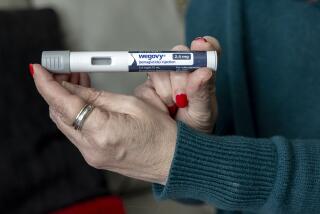We’re exercising more but still fighting obesity, study shows

Americans are exercising more, but that has not done much to slim their waistlines, underscoring the immense challenge confronting doctors and health advocates fighting the nation’s obesity crisis.
In more than two-thirds of the nation’s counties — including some of the unhealthiest — men and women became more physically active over the last decade, according to data published Wednesday in the online journal Population Health Metrics. Three-quarters of California’s counties saw gains in physical fitness for both men and women.
Women made much more progress than men in raising the level of physical activity. The percentage of California women who got sufficient weekly exercise increased from 50.7% to 59.2% from 2001 to 2011, while the percentage of physically active men increased from 59.4% to 61.3%.
But these improvements have done little to reduce obesity, researchers at the University of Washington’s Institute for Health Metrics and Evaluation concluded.
In California, obesity rates increased in every county between 2001 and 2009. National rates also climbed, although some recent evidence suggests the rates may be leveling off.
“There has been a lot of progress on physical activity,” said Christopher Murray, lead author of the research. “But we probably also need to do more. There are still more calories coming in ... than calories going out in physical activity.”
Today, more than one-third of U.S. adults and about 17% of children are obese, according to the federal Centers for Disease Control and Prevention.
Many health experts say exercise helps prevent disease but that the only way to lose weight is through dietary changes. People need to reduce their insulin levels by drinking less alcohol and eating less sugar, trans fats and corn-fed beef and chicken, said Robert Lustig, a neuroendocrinologist and clinical professor at UCSF School of Medicine.
“There is not one study anywhere in the world that shows that exercise causes weight loss,” he said. Poor diet also reduces the will to exercise, he said. “The biochemistry drives the behavior.”
A separate paper by the institute published Wednesday in the Journal of the American Medical Assn. identified poor diet as the No. 1 factor contributing to America’s poor health compared to other industrialized nations.
At a White House event Wednesday for community leaders involved in the fight against obesity, First Lady Michelle Obama cited the newly released research, noting it “makes clear that poor nutrition is the single greatest cause of preventable diseases.”
“Seems obvious, but we still resist the truth,” she said.
Life expectancies in the United States stagnated for women in 1,405 counties and for men in 154 counties between 1985 and 2010, researchers reported. And Americans living in the nation’s worst-performing counties, in Appalachia, now live shorter lives than people in Vietnam, Yemen and Sudan.
Despite the grim news, Murray and others believe the uptick in exercise is likely eventually to deliver significant health benefits.
“Exercise has amazing virtues,” said Georges C. Benjamin, executive director of the American Public Health Assn. “It helps prevent cardiovascular disease, build muscle tone and reduce bone loss. It improves mental health, and it reduces stress. … All of those are vitally important.”
Some of the biggest gains in physical activity over the last decade occurred in America’s unhealthiest counties in the Deep South and Appalachia. Overall, six of the 10 counties that improved most for men and seven of the 10 that improved most for women are in Kentucky.
Counties around California also saw significant increases in physical activity, according to the report. The counties that improved the most for women were Stanislaus, Mariposa and Merced, and for men, Stanislaus, Tehama and Lake.
In Los Angeles County, 59.5% of men and 55.5% of women got sufficient exercise in 2011. Researchers defined sufficient physical activity as 150 minutes of moderate activity a week or 75 minutes of vigorous activity.
Researchers did not say what may explain the successes. But George Flores, a physician and program manager at The California Endowment, said he believed increased awareness, neighborhood changes, the first lady’s exercise initiative and policy changes all contribute to people exercising more.
Flores said that the messages about the benefits of healthy eating and exercise are getting through to many people and communities. Cities across the state have built parks, added sidewalks and invested in farmers markets and grocery stores. But there is still a “patchwork of progress,” he said. “Things have to change so there are fewer barriers to healthy behaviors.”
Even with the improvements, huge disparities exist in California and the U.S. in both exercise patterns and obesity. In the least healthy counties nationally, fewer than a third of women and fewer than four in 10 men got sufficient physical exercise, according to the report.
In California, only 45% of women and 46% of men were sufficiently active in Imperial County in 2011, the lowest percentage in the state. On the other end of the spectrum, 74% of women in Marin County and 72% of men got sufficient exercise — the highest in the state.
Merced County had the highest obesity rates for men and women in 2011, and San Francisco County had the lowest.
More to Read
Sign up for Essential California
The most important California stories and recommendations in your inbox every morning.
You may occasionally receive promotional content from the Los Angeles Times.











